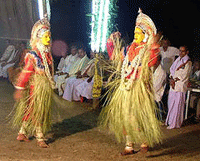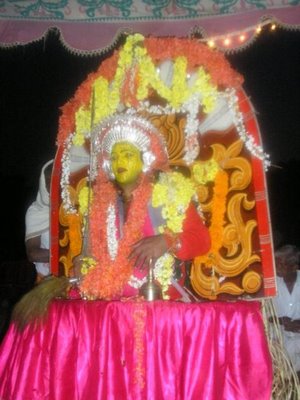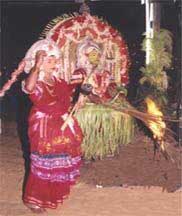Bhoota Kola - Essence of Tuluver
Few months ago, when my parents decided that we would perform “Bhoota Kola” at our hometown near moodabidri, I was very excited. Hence postponed the dates to last week of December, speculating that I would take Xmas and NY holidays to attend this function which was organized by us. The last time, we had done that was 20 years ago. I don’t remember much as I was only a small kid then. But, what I remember, pakku was damn afraid of the proceedings and had slept midway through it.
Now, when the D-day has come, I am miles away from my family, trying to get each and every minute detail like food menu (only Veg), invite card, people attendance blah blah, to pacify myself that I am indeed an integral part of the happenings. I am seriously missing being part of such an occasion. And I know, my folks in hometown are missing a bit more, after all “kinniyayae” (tulu word for the pampered last son of the family) is adored by everyone hehehehe.
As the days fly for the final showdown (29 night-30 morning), I am getting a bit more enthufied and cursing circumstances which has made me stay back in Singapore. Anyways, hope it goes on smoothly and the villagers/relatives/well-wisher prayers are answered satisfactorily and on a selfish note, praying for a bit more blessings/wishes for our family. Above all, “Sarve janaaha Sukhino bhavantu”
Few details on “Bhoota Kola” accumulated from web.
*****************************************************
Now, when the D-day has come, I am miles away from my family, trying to get each and every minute detail like food menu (only Veg), invite card, people attendance blah blah, to pacify myself that I am indeed an integral part of the happenings. I am seriously missing being part of such an occasion. And I know, my folks in hometown are missing a bit more, after all “kinniyayae” (tulu word for the pampered last son of the family) is adored by everyone hehehehe.
As the days fly for the final showdown (29 night-30 morning), I am getting a bit more enthufied and cursing circumstances which has made me stay back in Singapore. Anyways, hope it goes on smoothly and the villagers/relatives/well-wisher prayers are answered satisfactorily and on a selfish note, praying for a bit more blessings/wishes for our family. Above all, “Sarve janaaha Sukhino bhavantu”
Few details on “Bhoota Kola” accumulated from web.
*****************************************************
Bhoota Kola is a form of 'Bhuta Aradane' or worship of holy spirits , widely followed in South Canara & parts of Kerala.Bhoota or Daiva is a holy spirit and Bhoota Kola is all about paatri ( impersonator ) also called as 'Nalke' in tulu, getting possessed by holy spirit. It is a worship which starts after the dusk and can go on till the early morning.In short to sum it up, Bhoota Kola is system of rituals,social gathering, miraculous healing of ailments and solutions to problems.

The holy spirit is also known as 'Daiva' or ‘Bhoota’. Mostly this is relevant to few families which have been following this for hundreds of years. Such families might have a small temple like structure built which is known as 'Bhootada Gudi'. These families rely on the holy spirit to shower them with good fortune and protect them from the evil.

Traditional attire
The (person who represents) bhoota is dressed in a red blouse and trousers. The make-up is the most important thing while the bhoota is being readied for the pooja. Normally red, black, yellow, blue and white are the colours used to decorate the face of the bhoota. As they begin painting the lines on the face of the bhoota, the traditional songs or the paddanas are sung. The stories related to the bhootas are recited and the bhoota is finally ready for the show.
Fronds of coconut and areca trees, wild flowers, bamboo shoot are an integral part of the attire of the bhoota. But with the changing times, ornaments made of gold, silver, bronze and other materials have replaced the older materials.

The mask
The mask worn by the bhoota is perhaps the most important aspect . The bhoota is a symbol of great power and violence. The mask of the bhoota is worshiped in temples. The mask is decorated with gold and silver ornaments and is worshiped according to the rituals.
Some masks are that are made of areca fronds are temporary and discarded after the worship. The masks for Panjurli, Kalkuda bhootas are made of iron and areca fronds while those of Ullalti, Kadamanittaya, Rakteshwari, Juwadi and Malaraya are made using iron and other metals.

Body beautiful
Normally bamboo or cane sticks are used for the body, and areca and coconut fronds are used as attachments. The shape of the body varies from semi-circle, triangle or rectangle. The shape depends on the spiritual significance of the bhoota.
The behaviour
The bhoota involves itself in a great many ‘miraculous acts,’ like rolling on the fire. As it get's closer to possession of the spirit tempo depth increases. A typical costume is a gown made of palm leaves and a big nimbus like structure called "ani" made of palm leaf and decorated by few ornaments.

Though Bhoota Kola is not a public event,it is common for the neighbours from surrounding places to gather at the house where it happens. Few come for pure entertainment & few seeking solution to their problems.After the possession of the holy spirit the paatri answers questions fired at him by the gathered people, mostly such questions on nagging problems & difficulties faced by them. The Holy Spirit answers them by providing solutions to their problems.

2 Comments:
Hmmm!!! Good Information about different cultural aspects. I was unaware of this even though I am form this place.
THough this is a bit out of context and you have talked about positive energy of spirits, my mind wandered around "Guddada Bhoota" Series that was aired in DD long time back....I was scared to watch it...but couldn't resist from watching!
nice write up...landed here while looking for info on kola..:) Thanks for sharing
Post a Comment
<< Home